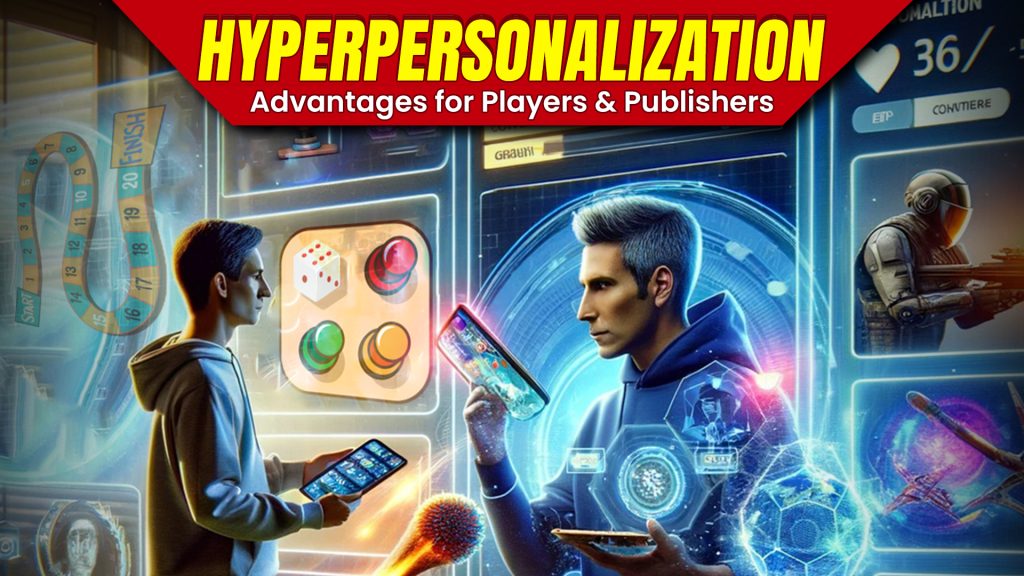In the ever-evolving landscape of the gaming industry, the quest for delivering an unparalleled player experience has led to the emergence of hyperpersonalized gameplay. This cutting-edge approach goes beyond traditional game design, leveraging advanced technologies and data analytics to tailor every aspect of the gaming experience to the individual player.
What is hyperpersonalization in mobile games?
Hyper-personalization in mobile games refers to the use of advanced data analytics and machine learning techniques to deliver highly customized and personalized gaming experiences to players. This approach goes beyond traditional personalization methods by tailoring not only game content but also game mechanics, challenges, rewards, and interactions based on the specific preferences, behaviors, and playing styles of each player.
Hyperpersonalization involves the dynamic adaptation of game mechanics, and challenges based on the player’s preferences, behaviors, and skill level. This goes beyond the superficial customizations seen in character creation screens, extending into the very fabric of the gaming experience. The core idea is to create a seamless and immersive journey that feels uniquely crafted for each player, enhancing engagement and satisfaction.
How is hyper-personalization implemented in mobile games
Data Collection and Analysis:
- Player Profiling: Game developers collect various data points about the player, including gameplay habits, preferences, skill levels, in-game behavior, and purchasing history.
- Behavioral Tracking: Tracking player behavior within the game, such as the levels they play most frequently, the items they interact with, and the choices they make, provides valuable insights for personalization.
Machine Learning and AI Algorithms:
- Predictive Analytics: Machine learning algorithms analyze player data to predict future behavior and preferences, enabling the game to anticipate the player’s needs and adapt the gaming experience accordingly.
- Recommendation Engines: Advanced recommendation systems suggest personalized content, challenges, rewards, and in-game purchases based on the player’s profile and behavior.
Dynamic Content Adaptation:
- Adaptive Difficulty: The game adjusts the difficulty level and challenges in real-time based on the player’s skill level, ensuring an optimal level of challenge and engagement.
- Personalized Game Environment: The game can dynamically change the game environment, characters, and story elements to align with the player’s preferences and progress.
Personalized Rewards and Incentives:
- Tailored Bonuses and Rewards: Players receive customized rewards, bonuses, and incentives that are specifically designed to match their interests, playing style, and progression in the game.
- Personalized In-Game Offers: The game provides personalized offers and promotions for in-game purchases, upgrades, and special events, encouraging players to make purchases that resonate with their preferences.
Adaptive Game Mechanics:
- Real-Time Adaptation: The game adapts its mechanics in real-time to create a more engaging and challenging experience for the player, ensuring that the gameplay remains fresh, exciting, and relevant to the individual player.
- Dynamic Content Generation: The game can generate new content, such as levels, challenges, and quests, based on the player’s profile and progress, ensuring a personalized and continuously evolving gaming experience.
Social and Community Features:
- Personalized Social Interactions: Hyper-personalization can facilitate more meaningful and personalized social interactions between players, such as personalized matchmaking, team formation, and collaborative gameplay experiences.
- Customized Social Challenges: The game can create personalized social challenges and competitions based on the player’s preferences and social connections, enhancing social engagement and community interaction.
Continuous Learning and Improvement:
- Feedback Loop: The game continuously learns from the player’s interactions and feedback to refine and improve the personalized gaming experience over time.
- Iterative Optimization: Game developers use A/B testing and iterative optimization techniques to test and refine the personalized features and content, ensuring long-term engagement and satisfaction.
Future Implications of hyperpersonalized gameplay
The future of hyperpersonalized gameplay holds vast potential. As technologies continue to advance, we can expect even more sophisticated and nuanced adaptations, possibly blurring the lines between traditional single-player and multiplayer experiences. The intersection of virtual reality, augmented reality, and hyperpersonalization could usher in an era where games become not just a form of entertainment but a truly personalized and immersive digital journey.
Final word
The hyperpersonalized gameplay experience represents a paradigm shift in the gaming industry. By leveraging AI, big data, and neural networks, developers can create games that transcend generic experiences, offering players a deeply personalized journey. As the industry continues to evolve, the ethical implementation of hyperpersonalization will be paramount, ensuring that players have agency over their gaming experiences while enjoying the benefits of this groundbreaking approach. The future of gaming is personalized, adaptive, and limitless.

